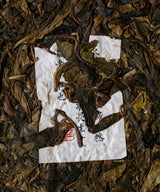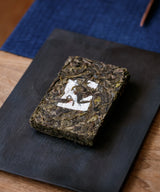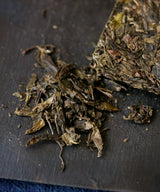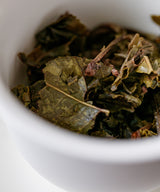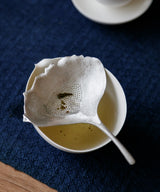Ancient Tree Yellow Leaf
古树老黄片
Harvest
April 2022
Origin
Jinggu, Yunnan
In 2006 Tang Wang left his corporate job in the city, Kunming, and rented a small place in rural Yunnan where his only intentions were to read, reflect, and drink tea with friends. In one of these chats an old friend, Li, suggested that Tang grow tea in Li’s hometown, Yangta Village. That July the two of them traveled to Jinggu in Yangta and leased 11 acres of forested area from Li’s niece.
The area they leased was wild growth, at about 6500 ft elevation. This is where they would eventually plant 70,000 Jinggu Big White tea trees. However, Tang found out, somewhat far into the process of planting, that one cannot harvest newly planted tea trees until they have stood in the ground for 3 years. Confronted with this long pause, Tang leased another tea garden in the mountain that locals had shown him; a highly regarded area that was home to ancient pu’erh trees. And so, while he waited for his Jinggu Big Whites, Tang began making pu’erh from these very old trees.
One of the teas Mr. Tang produces is a traditional kind of pu’erh called “Yellow Leaf.” “Yellow Leaf” does not refer to a varietal of pu’erh, but rather a grade of pu’erh raw made from any older leaves that turn slightly yellow during pan-frying.
We are big fans of Yellow Leaf pu’erhs for a few reasons. First, they offer great value: Yellow Leafs are an accessible way to experience pu’erh from coveted villages and ancient trees that would otherwise be inaccessible, in both availability and price. Second, Yellow Leafs are generally more gentle and sweeter on the palate, being made from leaves that were slightly older when they were harvested. They are high quality and uncomplicated pu’erhs that still offer the depth and energy that makes pu’erh so specifically enjoyable.
Mr. Tang shared this Yellow Leaf with us last year. He crafted it from arbor trees between 200 and 300 years old. He told us that this pu’erh is what he drinks daily, and described it as very good tea, albeit slightly rustic: “like teas that tea farmers like to drink.”
We were unexpectedly charmed by this Yellow Leaf; at how much clarity and energy it had to offer, while still being very light-hearted. We would drink this tea on a bright morning, when we want something even and light hearted, while still being grounding. This tea has the gift of not being too directive or attention-occupying, making it an excellent companion tea to other tasks.
. . .
Brewing guide
| Tea | 4 g |
| Temperature |
100°C |
| Water | 120 ml |
| Steep time | 10 - 60 sec |
| No. of infusions | 8 |

